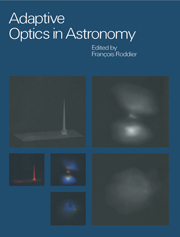Book contents
- Frontmatter
- Contents
- List of contributors
- Part one Introductory background
- Part two The design of an adaptive optics system
- Part three Adaptive optics with natural guide stars
- Part four Adaptive optics with laser beacons
- Part five The impact of adaptive optics in astronomy
- 14 Observing with adaptive optics
- 15 Astronomical results
- 16 Future expectations
- Glossary of acronyms
- Index
16 - Future expectations
from Part five - The impact of adaptive optics in astronomy
Published online by Cambridge University Press: 23 November 2009
- Frontmatter
- Contents
- List of contributors
- Part one Introductory background
- Part two The design of an adaptive optics system
- Part three Adaptive optics with natural guide stars
- Part four Adaptive optics with laser beacons
- Part five The impact of adaptive optics in astronomy
- 14 Observing with adaptive optics
- 15 Astronomical results
- 16 Future expectations
- Glossary of acronyms
- Index
Summary
Covering all the aspects of adaptive optics (AO) in astronomy is a challenging task. Inevitably there have been omissions as well as redundancies. Moreover, the field is still rapidly evolving. Techniques which have been described in detail may become obsolete, whereas others barely mentioned in this book, may gain importance. Nevertheless, we hope this book will be found useful by both engineers who need to build AO systems for astronomy, and astronomers who want to observe with them.
A highly debated topic is the use of laser guide sources (LGS) instead of natural guide sources (NGS). We use here the word ‘sources’ rather than the more widely used word ‘stars’, because not only LGS, but also many NGS are not stars. In view of recent developments, it seems fair to say that the use of NGS has given better results than many people anticipated. Most of the astronomical results published to date have been obtained with NGS systems, and as seen in Fig. 15.2, the number of publications obtained with them is growing very rapidly. Significant image improvement can now be obtained in the infrared with guide sources as faint as V = 15 or 16. Also, – at least on good astronomical sites – the isoplanatic patch size was found to be larger than originally anticipated. At the CFH telescope, it is not uncommon to observe only a 10% loss of Strehl ratio in the H band, 20″ away from the guide star.
- Type
- Chapter
- Information
- Adaptive Optics in Astronomy , pp. 399 - 402Publisher: Cambridge University PressPrint publication year: 1999



